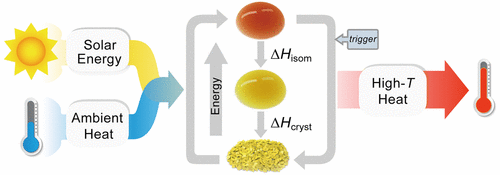当前位置:
X-MOL 学术
›
J. Am. Chem. Soc.
›
论文详情
Our official English website, www.x-mol.net, welcomes your
feedback! (Note: you will need to create a separate account there.)
Photochemical phase transitions enable co-harvesting of photon energy and ambient heat for energetic molecular solar thermal batteries that upgrade thermal energy
Journal of the American Chemical Society ( IF 14.4 ) Pub Date : 2020-06-17 , DOI: 10.1021/jacs.0c03748 Zhao-Yang Zhang 1 , Yixin He 1 , Zhihang Wang 2 , Jiale Xu 3 , Mingchen Xie 1 , Peng Tao 3 , Deyang Ji 4 , Kasper Moth-Poulsen 2 , Tao Li 1
Journal of the American Chemical Society ( IF 14.4 ) Pub Date : 2020-06-17 , DOI: 10.1021/jacs.0c03748 Zhao-Yang Zhang 1 , Yixin He 1 , Zhihang Wang 2 , Jiale Xu 3 , Mingchen Xie 1 , Peng Tao 3 , Deyang Ji 4 , Kasper Moth-Poulsen 2 , Tao Li 1
Affiliation

|
Discovering physicochemical principles for simultaneous harvesting of multiform energy from environment will advance current sustainable energy technologies. Here we explore photochemical phase transitions-a photochemistry-thermophysics coupled regime-for co-harvesting of solar and thermal energy. In particular, we show that photon energy and ambient heat can be stored together and released on demand as high-temperature heat, enabled by room-temperature photochemical crystal↔liquid transitions of engineered molecular photoswitches. Integrating the two forms of energy in single-component molecular materials is capable of providing energy capacity beyond those of traditional solar or thermal energy storage systems based solely on molecular photoisomerization or phase change, respectively. Significantly, the ambient heat that is harvested during photochemical melting into liquid of the low-melting-point, metastable isomer can be released as high-temperature heat by recrystallization of the high-melting-point, parent isomer. This reveals that photon energy drives the upgrading of thermal energy in such a hybrid energy system. Rationally designed small-molecule azo-switches achieve high gravimetric energy densities of 0.3-0.4 MJ/kg with long-term storage stability. Rechargeable solar thermal battery devices are fabricated, which upon light triggering provide gravimetric power density of about 2.7 kW/kg and temperature increases of > 20 oC in ambient environment. We further show their use as de-icing coatings. Our work demonstrates a new concept of energy utilization-combining solar energy and low-grade heat into higher-grade heat, which unlocks the possibility of developing sustainable energy systems powered by a combination of natural sunlight and ambient heat.
中文翻译:

光化学相变能够共同收集光子能量和环境热量,用于提升热能的高能分子太阳能热电池
发现从环境中同时收集多种形式能量的物理化学原理将推动当前的可持续能源技术。在这里,我们探索光化学相变 - 一种光化学 - 热物理耦合机制 - 用于共同收获太阳能和热能。特别是,我们表明光子能量和环境热量可以存储在一起,并根据需要作为高温热量释放,这是通过工程分子光开关的室温光化学晶体↔液体转变实现的。将两种形式的能量整合到单组分分子材料中,能够分别提供超越仅基于分子光异构化或相变的传统太阳能或热能存储系统的能量容量。显着地,在光化学熔化成低熔点亚稳异构体液体期间收集的环境热量可以通过高熔点母体异构体的重结晶以高温热的形式释放。这揭示了在这样的混合能源系统中,光子能量驱动了热能的升级。合理设计的小分子偶氮开关可实现 0.3-0.4 MJ/kg 的高重量能量密度,并具有长期储存稳定性。制造可充电太阳能热电池装置,其在光触发时提供约 2.7 kW/kg 的重量功率密度,并且在周围环境中温度升高 > 20 oC。我们进一步展示了它们作为除冰涂层的用途。我们的工作展示了一种新的能源利用理念——将太阳能和低品位热能结合成高品位热能,
更新日期:2020-06-17
中文翻译:

光化学相变能够共同收集光子能量和环境热量,用于提升热能的高能分子太阳能热电池
发现从环境中同时收集多种形式能量的物理化学原理将推动当前的可持续能源技术。在这里,我们探索光化学相变 - 一种光化学 - 热物理耦合机制 - 用于共同收获太阳能和热能。特别是,我们表明光子能量和环境热量可以存储在一起,并根据需要作为高温热量释放,这是通过工程分子光开关的室温光化学晶体↔液体转变实现的。将两种形式的能量整合到单组分分子材料中,能够分别提供超越仅基于分子光异构化或相变的传统太阳能或热能存储系统的能量容量。显着地,在光化学熔化成低熔点亚稳异构体液体期间收集的环境热量可以通过高熔点母体异构体的重结晶以高温热的形式释放。这揭示了在这样的混合能源系统中,光子能量驱动了热能的升级。合理设计的小分子偶氮开关可实现 0.3-0.4 MJ/kg 的高重量能量密度,并具有长期储存稳定性。制造可充电太阳能热电池装置,其在光触发时提供约 2.7 kW/kg 的重量功率密度,并且在周围环境中温度升高 > 20 oC。我们进一步展示了它们作为除冰涂层的用途。我们的工作展示了一种新的能源利用理念——将太阳能和低品位热能结合成高品位热能,











































 京公网安备 11010802027423号
京公网安备 11010802027423号